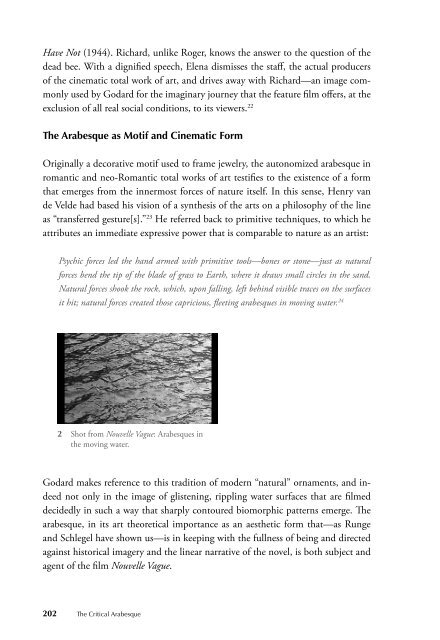The Death and Life of the Total Work of Art – Henry van de Velde and the Legacy of a Modern Concept
ISBN 978-3-86859-261-0
ISBN 978-3-86859-261-0
You also want an ePaper? Increase the reach of your titles
YUMPU automatically turns print PDFs into web optimized ePapers that Google loves.
Have Not (1944). Richard, unlike Roger, knows <strong>the</strong> answer to <strong>the</strong> question <strong>of</strong> <strong>the</strong><br />
<strong>de</strong>ad bee. With a dignified speech, Elena dismisses <strong>the</strong> staff, <strong>the</strong> actual producers<br />
<strong>of</strong> <strong>the</strong> cinematic total work <strong>of</strong> art, <strong>and</strong> drives away with Richard—an image commonly<br />
used by Godard for <strong>the</strong> imaginary journey that <strong>the</strong> feature film <strong>of</strong>fers, at <strong>the</strong><br />
exclusion <strong>of</strong> all real social conditions, to its viewers. 22<br />
<strong>The</strong> Arabesque as Motif <strong>and</strong> Cinematic Form<br />
Originally a <strong>de</strong>corative motif used to frame jewelry, <strong>the</strong> autonomized arabesque in<br />
romantic <strong>and</strong> neo-Romantic total works <strong>of</strong> art testifies to <strong>the</strong> existence <strong>of</strong> a form<br />
that emerges from <strong>the</strong> innermost forces <strong>of</strong> nature itself. In this sense, <strong>Henry</strong> <strong>van</strong><br />
<strong>de</strong> Vel<strong>de</strong> had based his vision <strong>of</strong> a syn<strong>the</strong>sis <strong>of</strong> <strong>the</strong> arts on a philosophy <strong>of</strong> <strong>the</strong> line<br />
as “transferred gesture[s].” 23 He referred back to primitive techniques, to which he<br />
attributes an immediate expressive power that is comparable to nature as an artist:<br />
Psychic forces led <strong>the</strong> h<strong>and</strong> armed with primitive tools—bones or stone—just as natural<br />
forces bend <strong>the</strong> tip <strong>of</strong> <strong>the</strong> bla<strong>de</strong> <strong>of</strong> grass to Earth, where it draws small circles in <strong>the</strong> s<strong>and</strong>.<br />
Natural forces shook <strong>the</strong> rock, which, upon falling, left behind visible traces on <strong>the</strong> surfaces<br />
it hit; natural forces created those capricious, fleeting arabesques in moving water. 24<br />
2 Shot from Nouvelle Vague: Arabesques in<br />
<strong>the</strong> moving water.<br />
Godard makes reference to this tradition <strong>of</strong> mo<strong>de</strong>rn “natural” ornaments, <strong>and</strong> in<strong>de</strong>ed<br />
not only in <strong>the</strong> image <strong>of</strong> glistening, rippling water surfaces that are filmed<br />
<strong>de</strong>ci<strong>de</strong>dly in such a way that sharply contoured biomorphic patterns emerge. <strong>The</strong><br />
arabesque, in its art <strong>the</strong>oretical importance as an aes<strong>the</strong>tic form that—as Runge<br />
<strong>and</strong> Schlegel have shown us—is in keeping with <strong>the</strong> fullness <strong>of</strong> being <strong>and</strong> directed<br />
against historical imagery <strong>and</strong> <strong>the</strong> linear narrative <strong>of</strong> <strong>the</strong> novel, is both subject <strong>and</strong><br />
agent <strong>of</strong> <strong>the</strong> film Nouvelle Vague.<br />
202 <strong>The</strong> Critical Arabesque


















